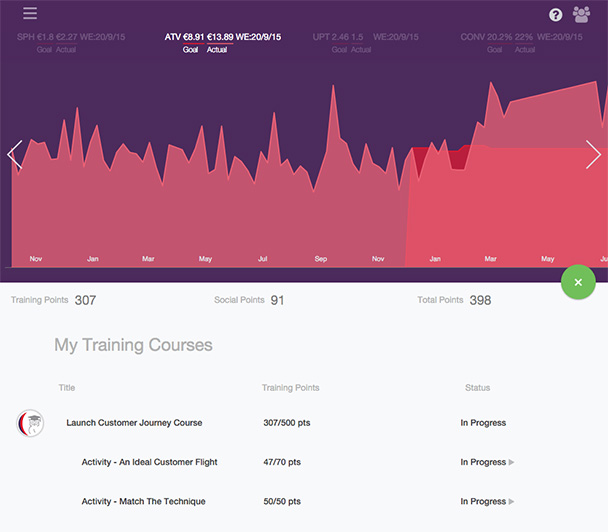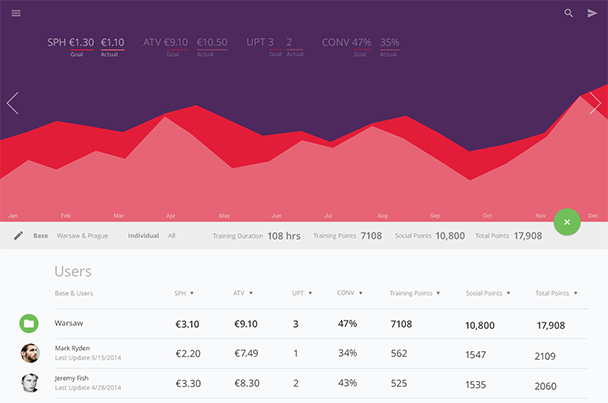More and more, we are seeing gamification defined in the details of its implementation. Its use is also becoming more diverse in order to match specific needs. Gamification can be very effective as a strategy and has been validated, so it is more than just a catchphrase. As a result, in conversation today, the word does not provide much information when someone simply says, “We use gamification.”
My team has seen “gamification” used to mean that some aspect of the learning experience is made into a contest, as well as meaning that a gaming platform was integrated directly into the training experience. In government training we have seen gamification worked into instructor-led training, eLearning, virtual reality, and immersive simulation. In all of these cases, gamification has become a strategy for effectively imparting new skills and development.
In Riptide Software’s business, we work with many different subject matter experts (SMEs) and instructional designers (IDs) in many different training subjects and use cases. Most today are trying to use some form of what could be called “gamifying” the learning experience. Whether the clients are commercial or government, we collaborate with them through our technology framework and multimedia design team, while they provide the learning content.
An example
Based on its use of both gamification and social collaboration, I offer a case study involving new technology that may be helpful to you in your own work.
I will refer to the client as Company X. This client is in the airlines, aviation, and travel services industry and is based in Europe. It has 29,000 employees and revenue of over $2.5 billion. Company X has a unique perspective in that they enhance the customer service of several airlines worldwide and help provide a revenue stream for those airlines. Since the company provides onboard (in-flight) sales services, they also provide sales training. Those training services were largely instructor-led training (ILT), and Company X wanted to launch a new technology-based training program to teach their sales techniques. Here’s how they did it.
Start with a pilot program/prototype
The first thing Company X did was to identify the need for a pilot program that would prove the principle of distance learning and gamification to the organization. This pilot program was identified in the RFP (request for proposal).
As a provider of new technology, I cannot stress enough that a pilot program or proof of principle is the way to go. You can control your costs, secure a win for new technology, and gain support within your organization for a broader implementation. I have seen these pilot programs go viral inside the organization in a way that generates excitement and action for more progress.
Across our organization, we often refer to this as a “crawl, walk, run” strategy. At Riptide, for 20 years we have adapted to and adopted all the new dominant software technology, and this strategy has worked very well for us. Every time our engineering team wants to try something new, we prototype and we perform decision analysis; we don’t just jump into something new without testing it first. The result of technology’s moving so fast is that many in our industry decide to do nothing rather than take what feels like a risky step toward something new. Technology is moving faster now than ever—don’t do nothing! A proof of principle, pilot, or prototype is a way for you to do something and help your company move toward modernizing their learning technology.
Set clear success criteria
The next thing Company X did was set clear success criteria for the pilot program that they had to meet before moving forward with the broader new-technology approach. The criteria were simple. For Company X, it was an increase of euros spend per head (SPH) by airline passengers. Once that could be shown from the training, and upon the key stakeholders’ approval, the corresponding additional phases of work could begin. In addition, the learners actually had to give positive feedback on the training experience.
The pilot program ran for three months out of Budapest with two different base regions, Warsaw and Prague. The entire pilot implementation included a learning portal, dashboard, 30 minutes of eLearning that works on any device, a sales-data dashboard, gamification (pointed activities and social collaboration), user surveys, assessment, and a certificate. The crews in Warsaw typically did worse during this period, and those in Prague typically did better. The key performance indicators (KPI) in this sales program were spend per head (SPH), units per transaction (UPT), average transaction value (ATV), and conversion rate (C%). These KPIs focused the airline crew efforts based on the demographics of the region.
Company X requirements and challenges
Airline crew members are mobile users, so the training had to be engaging, relevant, and mobile. Each airline crew member shared in the success of the crew, so a gamification learning environment was a good fit, as there is less of a cultural focus on tracking individual sales performance. In the sales situation, one crew member might be showing the product while the other handles payments. All of the actual sales performance for each flight is divided equally with each crew member. In addition, the airline crews do not consist of the same people on every flight. The way Company X incentivizes the individual is not by giving more sales commissions; the crew-member culture responds very positively to rewards like trips and other types of gifts.
The client wished to provide a blended online program based on its live sales-training program materials. They wanted to challenge learners to collaborate with one another via a social learning component. Crew members have both soft and hard KPIs with measurable sales goals that are adjusted or set according to customer demographics. It was also a requirement that the actual individual sales performance data and sales goals data must be showing on the learner portal. The Company X sales model requires a configurable learning experience that can take on the brand of their clients (airlines). Company X provides train-the-trainer training for the crew members of airlines. Experience API (xAPI) and learning record store (LRS) compliance was an early requirement, as was delivery to the smaller mobile form factor because Company X wanted to leapfrog over the training-technology approach of competitors. The client was also looking for a strategy to do away with the printed onboard menus that provide the crew with product knowledge.
Solution
So how did we define “gamification” for this case? We worked with Company X to provide a weighted points structure for complex learning activities and branching scenarios based on real situations and testimonies from onboard sales crew. The learner begins the training knowing that there is a maximum number of training points and social points that can be earned. The leaderboard allows individuals to see how their top crew-member colleagues are doing in their base region. Company X can incentivize the crew-member population with desirable gifts for those at the top of the leaderboard. The learner can also see the earned and maximum training points per activity in the dashboard, so they can relaunch activities to increase points. A social feed enabled giving points for sharing, commenting on, or liking something that another learner posted about crew sales.
All of this information was tracked in order to help establish success criteria using xAPI, an LRS, and Google Analytics. Incidentally, in xAPI there should not be multiple verbs for one meaning. There are some considerations in xAPI activity and verb vocabulary, all documented in Advanced Distributed Learning Initiative (ADL) publications. For this project, we shared and documented our approach in order to avoid going down the rabbit hole on how to get the training to report in the form of xAPI statements. At this point in xAPI adoption, it is considered best practice to research activities and verb types that already exist and use them before creating new ones. The xAPI vendors know how to deal with xAPI vocabulary, but it is not very complex if you want to do it yourself.
The point is, the xAPI specification has grown to accommodate social verbs even beyond what we did for this pilot. The sales success showed in the learning portal coming from the Company X sales system. The learner portal showed individual sales goals and actuals, and training points and social points added together to show total training points (Figure 1). A link in the learner-portal menu showed a leaderboard for the base region of the individual so they could see who had the most total training points (Figure 2).

Figure 1: Learner Portal Dashboard showing activity points, training points, social points, sales KPI goals, and sales actuals

Figure 2: Leaderboard view
Collaboration ensued to create a concept that would equal a base product for Company X’s airline clients. A mock airline company was created according to the client’s brand with an illustration and character style that allowed them to offer clients the option of branding to their particular airline. These efforts included a branding and styling guide, an “Airlines Style Guide,” that supported the client’s approved branding standards. Additionally, the program needed to meet the requirements of an international IT steering committee before pilot release.
Outcome
The pilot program delivered device-agnostic sales-training content to the client’s customers; a user portal that encourages social interactions; competition and analytics that provide detailed user experience views (via xAPI); and information from other systems integration about post-training individual and group sales performance. The effort included creating an interactive “product knowledge” component integrated into the learning portal, which puts the on-board service menu and product specials at the fingertips of crew members.
Company X gained UK industry recognition and was shortlisted for an eLearning Award for Best Use of Mobile Learning, largely because of the learning experience. The pilot case study also won in Innovation for Mobile and Social Collaboration (2016 Communicator Awards). Company X has since gone through a complete restructuring, renaming, and rebranding. Since all of the training materials are in an HTML5 framework, it is not a major undertaking to make the needed changes in CSS style sheets.
The pilot implementation also provided Company X with regular spreadsheets of pilot-usage data from the LRS and access to engagement metrics on Google Analytics dashboards. The surveys and feedback from crew members was overwhelmingly positive. At the end of three months, the pilot program was able to prove that the crew who took this training improved the spend per head by twice the success criterion. The crews in Warsaw improved their performance over their usual level, and the crews in Prague did even better.
This pilot became viral within the client’s business ecosystem. Furthermore, showing the pilot to other airlines generated presales for it as a training product. Company X was also able to release the pilot program to a second airline as an interim product. Much of the work done in the pilot or prototype was leveraged into the follow-on work.


